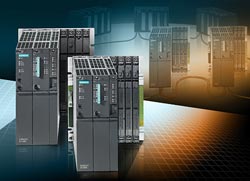Profinet and Profibus offer greater safety with fault-tolerant high-performance controllers

All CPUs now have a Profinet interface with a 2-port switch, larger memory and an expanded quantity structure for data and function block as well as function calls. One of the new functions concerns the master-reserve switchover that can now be programmed by the user.
The performance has also been improved with extended resources for communication, for example. The Profinet interface with a 2-port switch is used for plant communication and supports fault tolerant H-connections via TCP/IP (ISO on TCP). In combination with the integrated MPI/DP and Profibus DP interfaces, the new Profinet interface permits the system-redundant connection of IO devices.
Using fiber-optic cables, data synchronization is possible at distances of up to ten kilometers. In terms of performance, the new CPU 416-5H controller with 16 MB RAM is positioned between the 412-5H CPU with 1 MB, 414-5H with 4 MB and the 417-5H with 32 MB RAM. The controllers are programmed and configured using the Simatic Step 7 engineering tool. Start of delivery is planned for the first quarter of 2012.
The Siemens Industry Sector (Erlangen, Germany) is the world's leading supplier of innovative and environmentally friendly products and solutions for industrial customers. With end-to-end automation technology and industrial software, solid vertical-market expertise, and technology-based services, the Sector enhances its customers' productivity, efficiency, and flexibility. With a global workforce of more than 100,000 employees, the Industry Sector comprises the Divisions Industry Automation, Drive Technologies and Customer Services as well as the Business Unit Metals Technologies. For more information, visit http://www.siemens.com/industry
The Siemens Industry Automation Division (Nuremberg, Germany) supports the entire value chain of its industrial customers – from product design to production and services – with an unmatched combination of automation technology, industrial control technology, and industrial software. With its software solutions, the Division can shorten the time-to-market of new products by up to 50 percent. Industry Automation comprises five Business Units: Industrial Automation Systems, Control Components and Systems Engineering, Sensors and Communications, Siemens PLM Software, and Water Technologies. For more information, visit http://www.siemens.com/industryautomation
Reference Number: IIA2011113103e
Contact
Mr. Gerhard Stauss
Industry Automation Division
Siemens AG
Gleiwitzerstr. 555
90475 Nuremberg
Germany
Tel: +49 (911) 895-7945
gerhard.stauss@siemens.com
Media Contact
More Information:
http://www.siemens.com/s7-400hAll latest news from the category: Machine Engineering
Machine engineering is one of Germany’s key industries. The importance of this segment has led to the creation of new university degree programs in fields such as production and logistics, process engineering, vehicle/automotive engineering, production engineering and aerospace engineering among others.
innovations-report offers informative reports and articles covering technologies such as automation, motion, power train, energy, conveyor, plastics, lightweight construction, logistics/warehousing, measurement systems, machine tools and control engineering.
Newest articles

Properties of new materials for microchips
… can now be measured well. Reseachers of Delft University of Technology demonstrated measuring performance properties of ultrathin silicon membranes. Making ever smaller and more powerful chips requires new ultrathin…

Floating solar’s potential
… to support sustainable development by addressing climate, water, and energy goals holistically. A new study published this week in Nature Energy raises the potential for floating solar photovoltaics (FPV)…

Skyrmions move at record speeds
… a step towards the computing of the future. An international research team led by scientists from the CNRS1 has discovered that the magnetic nanobubbles2 known as skyrmions can be…





















